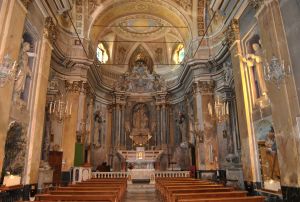The Parish church of the Pigna
The History
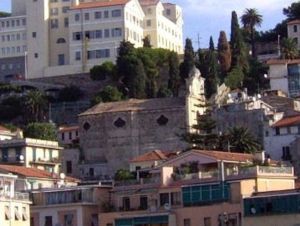 The church, located in the heart of the "Scarpéta" the old Sanremo, is easily accessible from every part of it. It is located close to the walls, which indeed
The church, located in the heart of the "Scarpéta" the old Sanremo, is easily accessible from every part of it. It is located close to the walls, which indeed 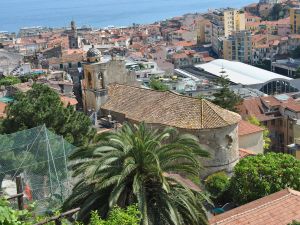 perforates with the apse, in a site not desired by the building expansion of the surrounding neighbourhood.
perforates with the apse, in a site not desired by the building expansion of the surrounding neighbourhood.
Nel "Sacro e Vago Giardinello", a Sanremo manuscript begun in 1621 and preserved at present in the Library of the Bishop's Curia of Albenga, makes no mention of this church. During the "Thirty Years or Salt War", in the book of the Decrees of the Community of San Remo, on March 3, 1625, we read:" Very Magnificent Lords, it is proposed to your Magnificent Lordships that to celebrate in the future the day of Saint Josephs bridegroom of the Most Glorious Virgin Mary and putative father of Jesus Christ as a solemn feast exhorting all the people to hear on that day the solemn mass that will have to be sung for the future every year at the altar of said saint existing in the church of the Annunciata dei R.R. Padri Zoccolanti..." (present church of N.S. degli Angeli).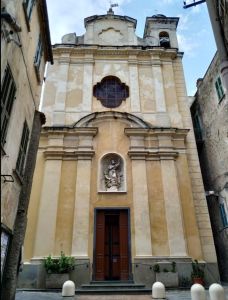 As can be deduced, the church of St. Joseph did not yet exist, otherwise the feast would have been celebrated in this church! Thanks to the quarrel that arose in 1687 between the Town Hall and the architect, Gio Martino, in charge of the construction of the church, we know not only the date of foundation of the present church, but also the progress of the works.
As can be deduced, the church of St. Joseph did not yet exist, otherwise the feast would have been celebrated in this church! Thanks to the quarrel that arose in 1687 between the Town Hall and the architect, Gio Martino, in charge of the construction of the church, we know not only the date of foundation of the present church, but also the progress of the works.
The work began in 1684 and on 28th February the walls of the church were built:"...by the same Master Gio himself, built up to the present sign (26th April1687), that is, all the walls were built up to the cornice... Mr. Fabricieri had no more money, and because the same Magnifico Conseglio ordered that the building of the "new church"... which is still discovered".
From the "Libro delle Delibere del Comune di San Remo" we read the succession of events that led to the construction of the church.
In 1685, on the 20th of March, it says "Wanting to begin to execute the vow made to build the church of San Gioseppe, they deliberated 3.000 lire for this purpose", and they gave the policy during the procession through the Chancellor, on the altar of said Saint".
In 1688, on the 6th May, two thousand liras were deliberated to the fabricators of S. Giuseppe, Giacomo Trucco and Gio Bartolomeo Bottino and on the 28th July another thousand liras.
In 1695, on 2nd September, 411.2 lire were paid to the factory worker Gio Batta Bottino 411.2 lire in that factory (church).
In 1724 Mr. Bartolomeo Bottini di Gio sold a small band belonging to the church of San Giuseppe nelle Rive:... with the obligation to spend the proceeds in the factory of the sacristy of said church.
In 1726, on the 20th of October, the Magnificent Council of Ministers decreed to the Consoli de fabri Murari Mastro Carlo Sasso, and Mastro Gio Maria Bresca to build his chapel in the church of S. Giuseppe in honour of SS. 4 crowned.
In 1727, on the 19th of January, on the 19th of January, the Consuls of the art of masonry, were obliged to build a chapel in the south of Capella, with the obligation to maintain the lobster roof of said chapel, and to provide the same with ornaments and candles on the day of its solemnity, and they had the permission to collect alms for the feast of the Holy 4 crowned by the notary Mr. Pier Francesco Martini.
In 1731, on the 4th of November, the farmers of this town, the Magnificent Council, made an over supplication by decree to the Consuls, and Gio Musso q. Antonio, Giacomo Aicardo quondam Batta were elected. Gio Maria Farixano q. Luca, and Gio Batta Scarella q. Antonio to build in the church of S. Giuseppe la Capella di S.Isidoro.
In 1732, May 10, the year it was decided to make the Chapel of St. Isidore by the Stucatore Colombo, who included Calcina, gipo ferri, and materials, L.345.
In 1733 25 March. The altarpiece of S. Isidoro was made in Genoa by Mr. Giacomo Boni Bolognese for 350 Lire and today it has arrived here, in S. Remo to be placed at the Chapel of the Workers in the church of S. Giuseppe in la Palma soprana and in L.350 vi and including the canvas, the canvas and the colours.
In 1737 at 28 Febraro Li Consoli di S. Isidoro began to build the Chapel of said Saint in the Church of S. Giuseppe, and in that year at 17 March was blessed said altar.
In 1740 to 27 Genaro were given 30 lire Mr. Giuseppe Bottini, farmer, for the palio to be served for the high altar of S. Giuseppe.
In 1751 in Febraro the high altar was made and detached in the Church of S. Giuseppe, which was previously part of the Sancta Sanctorum.
In 1752 on the 26th Febraro Mr. . Giuseppe Bottini, farmer, begged the Magnificent Council that after having tried with limosine to the restoration of the floor, to the remaking of the altar now again magnificent and decent, but since it is necessary to make a new altarpiece, not knowing where to take other alms given the miseries that run for both the people and the Community, he asked permission to alienate a large painting representing St. Sebastian in that existing church, to use the proceeds in the new altarpiece, and since this painting is totally useless, he counted on the Council for consent.
In 1833 the chaplain of St. Joseph the Rev. Bonfante Giuseppe presented a petition to the City Council in order to establish its own administration, attaching a draft regulation, which the same M. Council approved on 3 January 1843.
On the 9th of August 1853, in the choir of the Colleggiata di San Siro, in the late afternoon, the bull-decree of election as parish of the church of Santa Brigida was read. The church acted as parish for only 30 months; in fact on March 9th 1856 the seat was transferred from the church of St. Bridget to that of St. Joseph.
The parish counted 3.000 inhabitants. The first parish priest was the canon Leonardo Bottini. In 1856 the new parish wanted to have a bell tower. It was identified the most suitable site, but with surprise, at a depth of one metre, "to find the foundations already prepared".
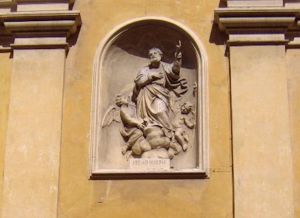 On the yellow ochre façade stands the sculptural group of the Glory of St. Joseph, made towards the end of the 19th century by an unknown sculptor, perhaps identifiable as Antonio Brilla. The figure of the saint, leaning against the niche, is The back of the church
On the yellow ochre façade stands the sculptural group of the Glory of St. Joseph, made towards the end of the 19th century by an unknown sculptor, perhaps identifiable as Antonio Brilla. The figure of the saint, leaning against the niche, is The back of the church
carved in high relief with the gaze upwards in an act of adoration and contemplation; on the base of the sculpture is engraved the biblical phrase: "Ite ad Joseph".
In the rear part of the church is visible a clock that functions regularly.
The interior of the church.
The interior has a single hall, spacious enough, with two curved side chapels connected to the presbytery.
On the architrave of the door there is an artistic bas-relief depicting St. Germano with the bishop's insignia, made in 1624 by a certain Gioffredo, as stated by the inscription of three lines engraved on the base of the sculpture. The vault of the building slightly outlines a Latin cross dome, while the fresco decoration of the nave is divided into two parts by a series of three large arches with a light yellow background. The first area is characterised by a central rose window with winged cherubs and garlands of pink flowers, two lateral pendentives with liturgical symbols and two horizontal bands with phytomorphic angels.
The vault of the building slightly outlines a Latin cross dome, while the fresco decoration of the nave is divided into two parts by a series of three large arches with a light yellow background. The first area is characterised by a central rose window with winged cherubs and garlands of pink flowers, two lateral pendentives with liturgical symbols and two horizontal bands with phytomorphic angels.
The second area, in the shape of a dome, is decorated with two fake stucco rosettes with a large rose window in the centre, and is decorated with three ovoli. This area is surmounted by the coat of arms of the city of Sanremo, which attests that the church was at the time of its construction exclusively 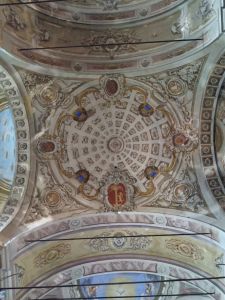 owned by the local community.
owned by the local community. 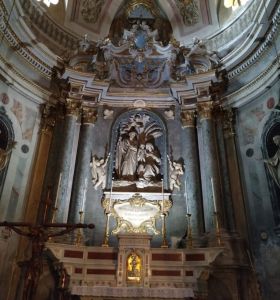 The basin of the apse instead represents a slice of blue sky with some cherubs portrayed on clouds, and the dove of the Holy Spirit in the centre. The architectural divisions of the presbyterial area were made in 1863 by the painter Michele Panizzi, while the vaults of the nave, completely rebuilt in 1881 by Pietro Passera, are certainly more solid than the previous ones.
The basin of the apse instead represents a slice of blue sky with some cherubs portrayed on clouds, and the dove of the Holy Spirit in the centre. The architectural divisions of the presbyterial area were made in 1863 by the painter Michele Panizzi, while the vaults of the nave, completely rebuilt in 1881 by Pietro Passera, are certainly more solid than the previous ones.
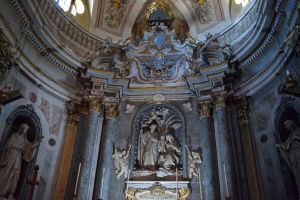 Leaning against the apse, the sculptural group of the Holy Family stands out in a particular way, with St. Joseph holding a flowered stick and the seated Madonna holding the Child in her right arm, while at the top an angel slightly bends a palm branch.
Leaning against the apse, the sculptural group of the Holy Family stands out in a particular way, with St. Joseph holding a flowered stick and the seated Madonna holding the Child in her right arm, while at the top an angel slightly bends a palm branch.
In the centre of the presbytery is the most original altar in western Liguria: apparently it looks like a medieval sarcophagus, but in reality it is a simple drinking trough, the same as the one placed in front of the Oratory of the Conception, which was in Via Nino Bixio, abandoned and badly reduced by neglect. Under pressure from Don Cortona, parish priest of San Giuseppe, an art connoisseur, the municipal administrators entrusted it to him and he had the brilliant idea of reusing it as an altar after having it restored under the guidance of the Superintendence.
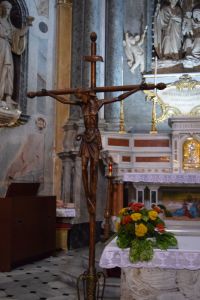 Next to the altar stands an artistic wooden Crucifix, which undoubtedly represents the most valuable work of the church. In it, the Christ, now dead, and formed almost entirely from bones alone, seems to be inspired by fifteenth-century models, even if the creation of the sculpture probably dates back to the sixteenth century.
Next to the altar stands an artistic wooden Crucifix, which undoubtedly represents the most valuable work of the church. In it, the Christ, now dead, and formed almost entirely from bones alone, seems to be inspired by fifteenth-century models, even if the creation of the sculpture probably dates back to the sixteenth century.
The four statues placed in the area of the presbytery and the two placed after the side altars were made in 1891 by the Savona sculptor Antonio Brilla, whose works, mostly with sacred subjects, adorn many churches in western Liguria, such as the parish church of Badalucco.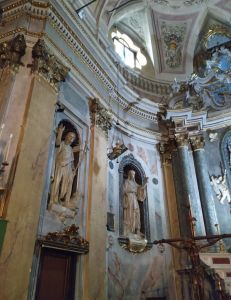 The first statue on the left side, in the niche with marble framing, depicts the patriarch Joseph, portrayed in pompous clothes in the act of raising a cup with his left hand, while on his right lies a sack of wheat; the second statue represents St. John the Baptist, portrayed in the act of announcing the coming of Jesus and with a cross-shaped stick, on which a banner is wrapped, in his left hand, while a tame lamb looks at the saint crouching at his feet. For this work Brilla was probably inspired by the 18th century statues of Domenico Parodi.
The first statue on the left side, in the niche with marble framing, depicts the patriarch Joseph, portrayed in pompous clothes in the act of raising a cup with his left hand, while on his right lies a sack of wheat; the second statue represents St. John the Baptist, portrayed in the act of announcing the coming of Jesus and with a cross-shaped stick, on which a banner is wrapped, in his left hand, while a tame lamb looks at the saint crouching at his feet. For this work Brilla was probably inspired by the 18th century statues of Domenico Parodi.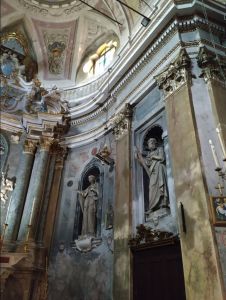 The first statue on the right side instead represents Esther, the protagonist of the homonymous book of the Old Testament, depicted in the act of supplication with her right arm raised and her left hand on her chest; the second statue on the right instead represents Saint Andrew the Apostle, with the typical "X" cross of his martyrdom.
The first statue on the right side instead represents Esther, the protagonist of the homonymous book of the Old Testament, depicted in the act of supplication with her right arm raised and her left hand on her chest; the second statue on the right instead represents Saint Andrew the Apostle, with the typical "X" cross of his martyrdom.
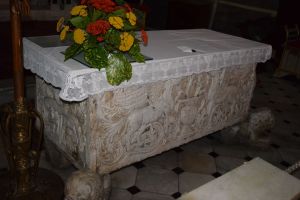 In the centre of the presbytery there is the most original altar in western Liguria: apparently it looks like a medieval sarcophagus, but in reality it is a simple drinking trough, the same as the one placed in front of the Oratoprio della Concezione, but which was in Via Nino Bixio, abandoned and badly reduced by neglect. Under pressure from Don Cortona, parish priest of San Giuseppe, an art admirer, the town administrators entrusted it to him and he had the brilliant idea of reusing it as an altar after having it restored under the guidance of the Superintendence.
In the centre of the presbytery there is the most original altar in western Liguria: apparently it looks like a medieval sarcophagus, but in reality it is a simple drinking trough, the same as the one placed in front of the Oratoprio della Concezione, but which was in Via Nino Bixio, abandoned and badly reduced by neglect. Under pressure from Don Cortona, parish priest of San Giuseppe, an art admirer, the town administrators entrusted it to him and he had the brilliant idea of reusing it as an altar after having it restored under the guidance of the Superintendence.
 The high altar, built in 1895 to a design by Pio Soli from Borra, is stylistically linked to the eclectic taste typical of the second half of the nineteenth century. In 1944 the altar was embellished with a mosaic depicting The Rest of the Flight into Egypt, made by Luciano Favret di Pietrasanta to a design by Viazzi from a canvas preserved in the Cathedral of Porto Maurizio.
The high altar, built in 1895 to a design by Pio Soli from Borra, is stylistically linked to the eclectic taste typical of the second half of the nineteenth century. In 1944 the altar was embellished with a mosaic depicting The Rest of the Flight into Egypt, made by Luciano Favret di Pietrasanta to a design by Viazzi from a canvas preserved in the Cathedral of Porto Maurizio.
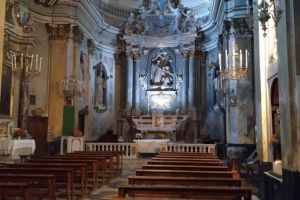 The presbyterial area is enclosed by two balustrades made by Alessandro Ricci in 1880 to a design by the first parish priest Leonardo Bottini, while on the left side of the presbytery was placed in 1954 the pulpit with an elegant design of a lily on white marble made by Antonio Brilla.
The presbyterial area is enclosed by two balustrades made by Alessandro Ricci in 1880 to a design by the first parish priest Leonardo Bottini, while on the left side of the presbytery was placed in 1954 the pulpit with an elegant design of a lily on white marble made by Antonio Brilla.
The decorations inserted in the niches can be traced back to the late neoclassical style and presumably date back to the mid-nineteenth century; on the wall hangs an oval painting, inserted in a gilded rectangular frame and decorated with stylized volutes of phytomorphic shoots, depicting the Madonna of Hope with Baby Jesus, made in 1837 by Lorenzo Martini and whose effigy was once linked to the Confraternity of the same name, made known in Sanremo by the Jesuit Father Gerolamo Durazzo.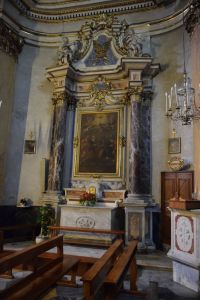 The chapel on the left, dedicated to the Four Crowned Saints, and built in December 1726 with the authorisation of the Major City Council, was painted in 1868 by Michele Parrini, while in 1883 Giovanni Baglioni made the columns and pilasters with fake marble together with those of the chapel of St. Isidore in front of it; the frontal and the tabernacle of the chapel date back to the beginning of the 20th century.
The chapel on the left, dedicated to the Four Crowned Saints, and built in December 1726 with the authorisation of the Major City Council, was painted in 1868 by Michele Parrini, while in 1883 Giovanni Baglioni made the columns and pilasters with fake marble together with those of the chapel of St. Isidore in front of it; the frontal and the tabernacle of the chapel date back to the beginning of the 20th century.
The painted, rectangular in shape, depicts the four saints kneeling in a hemicycle on a square tile floor; the saints, with their eyes turned to the sky, are dominated by the white dove of the Holy Spirit descending from above next to two cherubs that appear by magic in the clouds, while three little angels hold four crowns of  leaves and flowers in the centre, symbols of martyrdom. The painting is the work of Giovanni Battista Gastaldi (1585 ca. - after 1646), a painter from Trieste, who became a refined interpreter, together with his son Lorenzo (1625-1690), of a late 16th century matrix painting, which however spread throughout the Maritime Alps as far as Monaco and Nice.
leaves and flowers in the centre, symbols of martyrdom. The painting is the work of Giovanni Battista Gastaldi (1585 ca. - after 1646), a painter from Trieste, who became a refined interpreter, together with his son Lorenzo (1625-1690), of a late 16th century matrix painting, which however spread throughout the Maritime Alps as far as Monaco and Nice.
The Crowned Saints, protectors of the stonemasons and bricklayers, evidently residing in considerable numbers in the Pigna district, were particularly venerated by the local Brotherhood of Masons, in deference to a form of devotion still alive in the Baroque period and handed down, albeit in a milder way, even in later centuries. The Matuzian story of the Crowned Saints is also found in the chapel of the same name in the Cathedral of Santa Reparata in Nice.
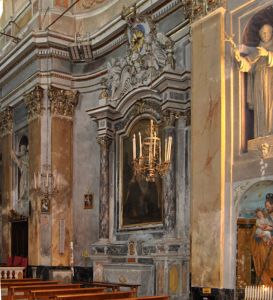 The chapel on the right, dedicated to Saint Isidore, was built in May 1732 by a plasterer named Colombo, on the initiative of the Consuls of the Company of Farmers, who had obtained permission to erect it in honour of their protector, following a resolution issued by the Major Council on 4th November of the previous year.
The chapel on the right, dedicated to Saint Isidore, was built in May 1732 by a plasterer named Colombo, on the initiative of the Consuls of the Company of Farmers, who had obtained permission to erect it in honour of their protector, following a resolution issued by the Major Council on 4th November of the previous year.
On 25th March 1733 the painting Madonna, Saint Isidoro and Saint Teresa of Avila, painted in 1723 by the Bolognese painter, pupil of Marcantonio Franceschini, Giacomo Antonio Boni (1688-1766), was placed there, also active in Sanremo at the Sanctuary of the Madonna della Costa.
The painted depicts the Virgin seated on a cloud with the Child between her knees and with St. Joseph on her right, while at her feet St. Isidore, dressed in a brown tunic and green cloak, is pleading with the Holy Family; on the left, the Virgin is invoked, with her hands joined, by St. Teresa d'Avila, wearing the brown dress with white cloak and the black veil of the Discalced Carmelite Sisters. 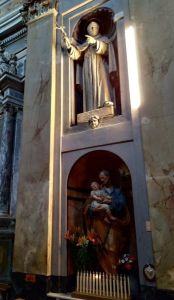
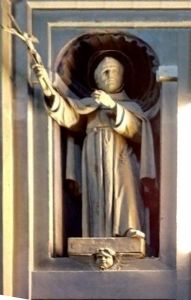 To the left of the Farmers' Chapel, leaning against the wall, is the statue of St. Leonardo da Porto Maurizio, by Antonio Brilla, who portrayed the Ligurian Franciscan saint holding the cross and pointing at it. St. Leonardo also had relations with Pigna, as on 28th March 1743 he had the body of the martyr St. Faustino, patron saint of the town's floriculturists, donated to the church of San Costanzo.
To the left of the Farmers' Chapel, leaning against the wall, is the statue of St. Leonardo da Porto Maurizio, by Antonio Brilla, who portrayed the Ligurian Franciscan saint holding the cross and pointing at it. St. Leonardo also had relations with Pigna, as on 28th March 1743 he had the body of the martyr St. Faustino, patron saint of the town's floriculturists, donated to the church of San Costanzo. 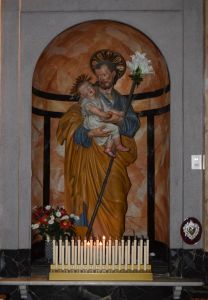 In the niche below there is the statue of St. Joseph, taken from the act of holding the Child and giving him an apple. The statue, made of plaster and painted with metal, represents a typical devotional work that came out of a Florentine artisan workshop of the twentieth century and was once in the Oratorio dei Dolori, from where it was transferred here, as a gift, by the curate Clemente Leoni.
In the niche below there is the statue of St. Joseph, taken from the act of holding the Child and giving him an apple. The statue, made of plaster and painted with metal, represents a typical devotional work that came out of a Florentine artisan workshop of the twentieth century and was once in the Oratorio dei Dolori, from where it was transferred here, as a gift, by the curate Clemente Leoni.
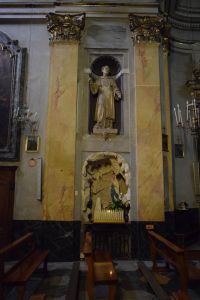 To the right of the chapel of the Crowned Saints is the last work by Antonio Brilla preserved in the church: the statue of Saint Stephen Protomartyr, represented
To the right of the chapel of the Crowned Saints is the last work by Antonio Brilla preserved in the church: the statue of Saint Stephen Protomartyr, represented 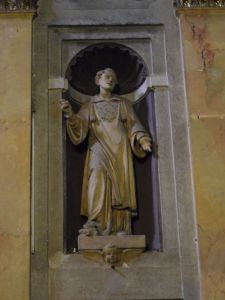 with his diaconal robe (the dalmatic) and with his right hand that once had to hold a palm tree, while his right foot rests on a stone, symbol of martyrdom.
with his diaconal robe (the dalmatic) and with his right hand that once had to hold a palm tree, while his right foot rests on a stone, symbol of martyrdom.
 In the niche below, the grotto of Massabielle has been recreated with the statues of Our Lady of Lourdes and Saint Bernadette Soubirous.
In the niche below, the grotto of Massabielle has been recreated with the statues of Our Lady of Lourdes and Saint Bernadette Soubirous.
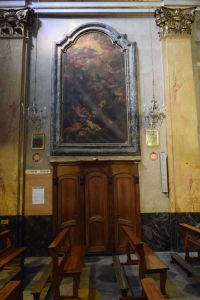 Above the left confessional, in a marble frame, is the painting The Glory of St. Joseph, by the Sanremo painter Girolamo Bosio, active in Sanremo in the second half of the 18th century.
Above the left confessional, in a marble frame, is the painting The Glory of St. Joseph, by the Sanremo painter Girolamo Bosio, active in Sanremo in the second half of the 18th century.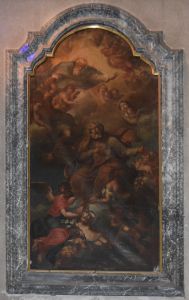 The painted represents St. Joseph supported by two angels in the act of looking up to heaven, while, on his left, God the Father turns to him with open arms. The free arrangement of the subject, the bright colours and the rapid, loose brushstroke suggest that the painting was made in the mid-eighteenth century.
The painted represents St. Joseph supported by two angels in the act of looking up to heaven, while, on his left, God the Father turns to him with open arms. The free arrangement of the subject, the bright colours and the rapid, loose brushstroke suggest that the painting was made in the mid-eighteenth century.
Above the right confessional is the painting depicting The Presentation of Jesus at the Temple, by an unknown 18th century painter and transferred here in 1881 from the public school oratory by the parish priest Don Leonardo Bottini. The painting was then cleaned and enlarged, to bring it to the same size as the canvas in front of it, by the painter Marchetti, who also made the upper part, in which the Divine Eye and the glory of the cherubs are depicted, while the general scenographic layout of the work seems to be attributable to the Genoese school of painting in the first half of the seventeenth century. 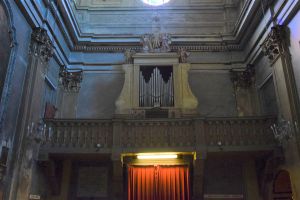 The organ above the entranceIn the wooden chancel above the main entrance there is an organ with a wooden case leaning against the back wall, adorned with pilasters and shaped side volutes and overlooked by some cherubs and angels musicians. The instrument was built in 1865 by the company of organ makers Nicomede Agati and his brothers from Pistoia, who also produced numerous other examples for many churches in Liguria. Inside the church there is also an anthropomorphic silver reliquary bust of San Costanzo, made as part of the production of Genoese silversmiths in the second half of the 16th century.
The organ above the entranceIn the wooden chancel above the main entrance there is an organ with a wooden case leaning against the back wall, adorned with pilasters and shaped side volutes and overlooked by some cherubs and angels musicians. The instrument was built in 1865 by the company of organ makers Nicomede Agati and his brothers from Pistoia, who also produced numerous other examples for many churches in Liguria. Inside the church there is also an anthropomorphic silver reliquary bust of San Costanzo, made as part of the production of Genoese silversmiths in the second half of the 16th century.
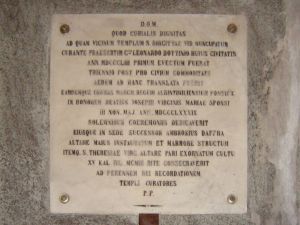 A plaque placed on the right side of the counter-façade recalls the transfer of the parish, with all its assets, from the oratory of St. Bridget to the present church of St. Joseph, by decree of the bishop of Ventimiglia Lorenzo Biale on 9th March 1856, and the solemn consecration of the church on 5th May 1889 by the prelate Tommaso Reggio, who also consecrated the high altar on that occasion.
A plaque placed on the right side of the counter-façade recalls the transfer of the parish, with all its assets, from the oratory of St. Bridget to the present church of St. Joseph, by decree of the bishop of Ventimiglia Lorenzo Biale on 9th March 1856, and the solemn consecration of the church on 5th May 1889 by the prelate Tommaso Reggio, who also consecrated the high altar on that occasion.
Above the organ, in the centre of the counter-façade, a stained-glass window by an unknown author, datable to the end of the nineteenth century, depicts the Glory of St. Joseph, while on the hexagonal yellow marble tile placed near the confessional there is a fossil shell, consisting of a Cephalopod mollusk, which has curiously survived to the present day without undergoing any significant evolution.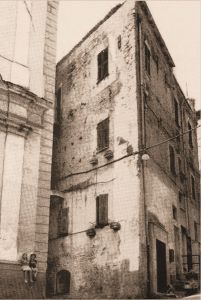 A few steps from the church is finally located the canonical house, which had a singular history as it was a monastery, first of the Franciscan tertiary nuns who founded the community of the Turchine, until 1660, then of the Salesians, who resided there from 1666 before moving to their new convent in the current Piazza Colombo (later destroyed during the Second World War), and then of the Discalced Augustinians, who rented it for twenty-one scudi a year.
A few steps from the church is finally located the canonical house, which had a singular history as it was a monastery, first of the Franciscan tertiary nuns who founded the community of the Turchine, until 1660, then of the Salesians, who resided there from 1666 before moving to their new convent in the current Piazza Colombo (later destroyed during the Second World War), and then of the Discalced Augustinians, who rented it for twenty-one scudi a year. 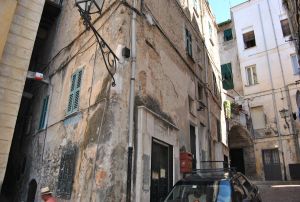 It later became the residence of the chaplain who officiated in the church of San Giuseppe. In 1853, the structure was registered in the name of the
It later became the residence of the chaplain who officiated in the church of San Giuseppe. In 1853, the structure was registered in the name of the
parish benefice and became the accommodation of the parish priest, while a century later its cellars were transformed into the «San Domenico Savio». cinema hall.
When the cinema was closed for reasons of usability, a part of the building was used as the seat of the local Scouts, while the other part was transformed into a chapel for the adoration of the Blessed Sacrament and is better known as the «Cripta di San Giuseppe».
(source texts: Andrea Gandolfo and other authors; source images: our archive)





